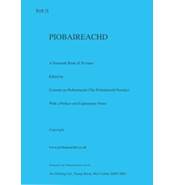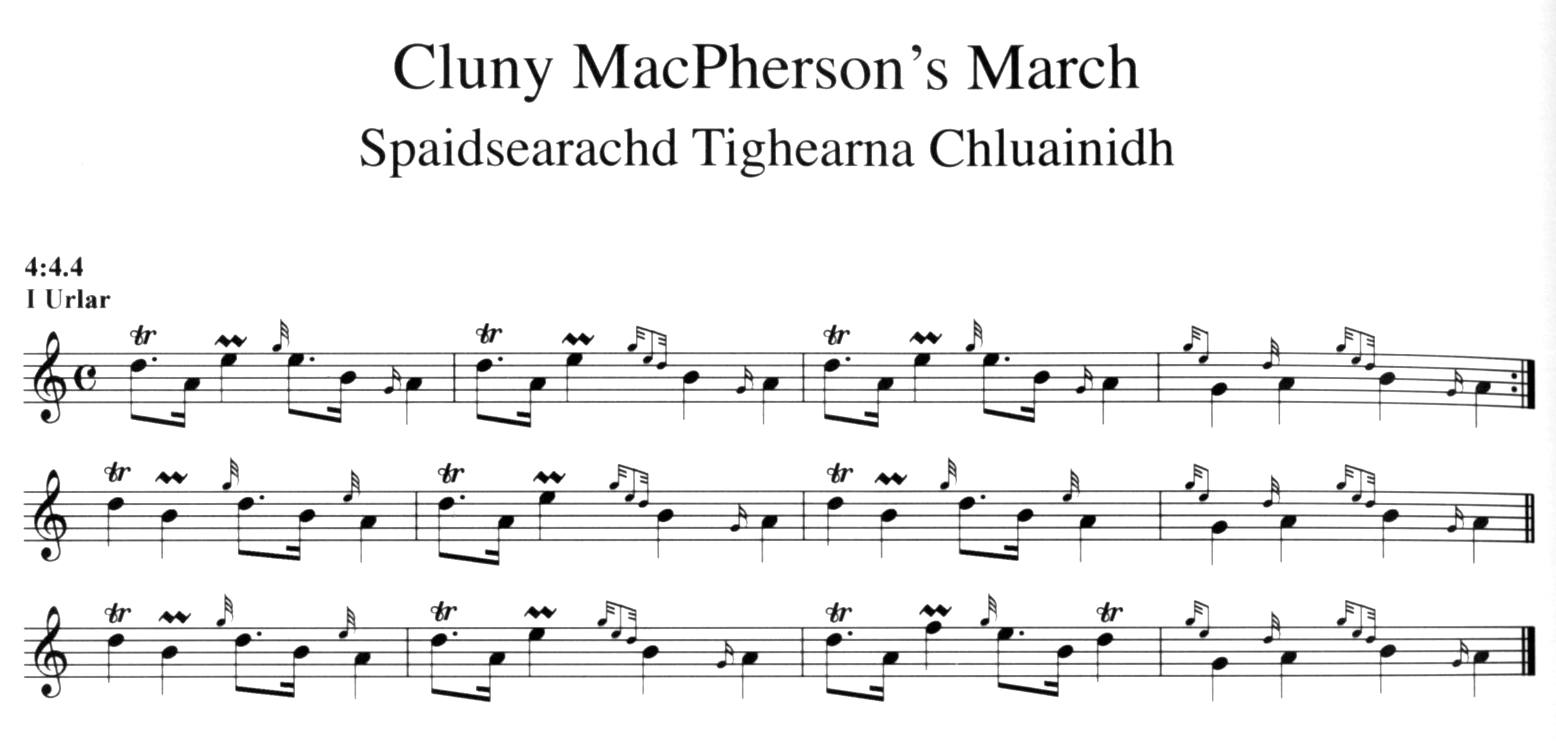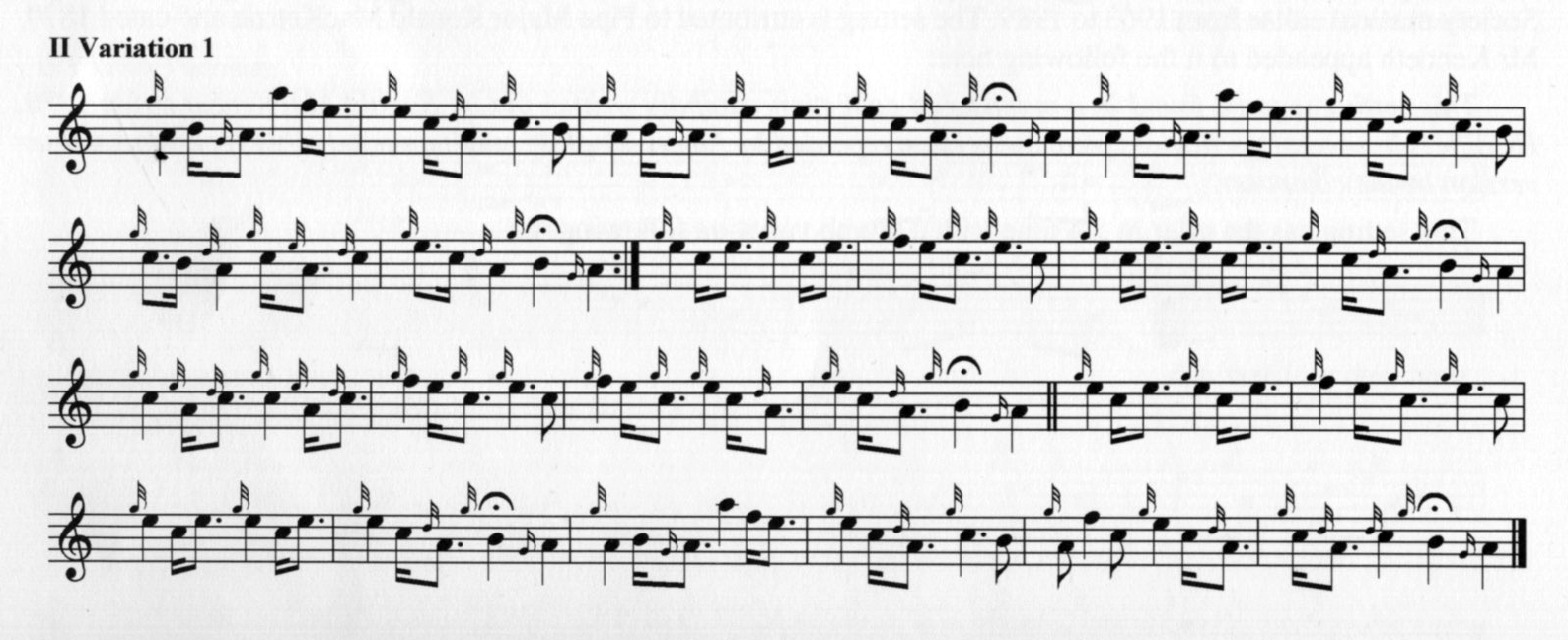By John KS Frater
It has been a pleasure to be asked to review Book 16 of the Piobaireachd Society Collection. Few, if any, people who might review this book would be free from some form of prejudice or bias re PS and its books – I am no exception.
I am a fan of this series of books, however, and a member of the Society, and I was one of those asked to demonstrate, at the PS Conference, some of the tunes from the then draft Bk 16 (a daunting, but ultimately enjoyable experience) ; I was not involved in the production of Bk 16 and have not been a member of the Society’s Music Committee.
 Bk16 presents a pleasing mixture ranging from well-known tunes with a twist (Glengarry’s Lament), the not recently published (Colin MacRae of Invereenat’s Lament), through a virtually unknown repertoire (some tunes quite possibly not played in living memory), to the reworking of tunes not perceived to have been in genuinely playable form before, notably the magnificent Nameless 96 from John MacDougall Gillies’ MS. The book covers the whole gamut of ceol mor from simple to complex and massive.
Bk16 presents a pleasing mixture ranging from well-known tunes with a twist (Glengarry’s Lament), the not recently published (Colin MacRae of Invereenat’s Lament), through a virtually unknown repertoire (some tunes quite possibly not played in living memory), to the reworking of tunes not perceived to have been in genuinely playable form before, notably the magnificent Nameless 96 from John MacDougall Gillies’ MS. The book covers the whole gamut of ceol mor from simple to complex and massive.
It’s great to find the PS reflecting in print, as it has at its conferences, the willingness of enthusiasts to explore a little known, sometimes effectively unknown, repertoire, especially with the explicitly stated and laudable aim of encouraging the playing of these pieces. Here we find tunes with exotic names – The Cave of Gold, The Fairy Flag – and one of the best tune titles in piobaireachd – The Frisky Lover!
Various sources are used, including John Smith’s MS, recently made available on PS website; it is particularly good to have William Ross’s 1885 book represented, with original scores given alongside. In a welcome development, these are not transcriptions, but actual reproductions, presumably scans of the original.
I was pleased to find PS house style preserved, especially with regard to size, layout and so forth, the reassuringly familiar format, the traditional approach for this series of presenting a score suitable for performance, with accompanying high quality notes indicating source, amendments, alternatives, sometimes bit of history, though I would have liked to see amendments marked with numbers on the scores, as in early books in the series, with relevant comment enumerated within the accompanying notes.
A few of the tunes illustrate an issue, not only with this book, but with the whole series, namely the tendency to change Angus MacKay’s timings and time signatures when there is no clear reason so to do. I accept that it appears that Angus MacKay often defaults to 6/8 timing for taorluath and crunluath variations, even where common time feels right, but he is more discriminating in urlars and early variations. Angus Mackay gives the grounds of the Frisky Lover and the Lament for the Great Supper in 2/4, which seems to me the natural metre for these tunes (same issue arises elsewhere, for example in Bk 15, Lachlan MacNeill of Kintarbert’s Salute); in the Nameless Tune 37 from Angus MacKay, the pointing of the first bar is altered to avoid square playing, but making it cut & dot removes the subtlety offered by Angus MacKay’s score. In Cluny MacPherson’s March, Angus MacKay’s version of urlar Line 1 Bar 4 seems to me to give a better guide to timing than the version in Bk16:


Cluny MacPherson’s March is an attractive wee tune; as with several other tunes in the book, the setting presented is from General Thomason’s famous Ceol Mor. Book 16’s accompanying notes do not mention, what is for me, the most interesting aspect of this tune: in his score, Angus MacKay gives a standard crunluath fosgailte variation, as in Book 16; he follows this with a crunluath doubling with ‘open’ fosgailte crunluaths, in other words a variation of the type reportedly played by Alick Cameron as a ‘fosgailte a mach’, thus Angus MacKay gives a historical source precedent for this apparently controversial sequence of variations.
[wds id=”13″]
Only a handful of tunes are named in the original preface to Book 1 of the PS collection: one of these is the huge Piper’s Salute to his Master, there mentioned as a tune in William Lamont’s MS of 1847, but in Bk16 based on the setting in General Thomason’s Ceol Mor. As mentioned in the notes, and incidentally in the late Roderick Cannon’s General Preface to the PS books, the William Lamont MS of 1847 is now lost. It was available to the Society’s editors in the early 20th century and listed as one of the sources consulted for Book 1. I haven’t yet got to grips with this tune, but some day…
I am not convinced by the comments about the timing of the first variation of General Thomason’s well known composition, Hail to my Country. This has been published in recent times in Donald MacLeod’s Book 4 and I understand was a tune much liked by RU Brown, who broadcast it. [The tune is also published in the recent book by James MacIntosh and well worth reference…Ed.]
The first variation was originally and previously given in 6/8, which seems correct and is the timing played by RU Brown; the editors have given it here in common time, which doesn’t work for me.


My main problem with this lovely tune has always been the throw to high A in line 1 bar 1 and elsewhere, which sounds clumsy, and I feel a worthwhile change would be a transposition to a euphonious sequence of gracenotes, viz F, low A, high G, low A.
Hector Roy MacLean’s Lament, from Wm Ross’s book, is an attractive, alternative setting of Lament for Red Hector of the Battles (PS Bk4), with taorluath and crunluath variations; unusually, the crunluath variation also containing taorluaths.
Lament for Colonel Forbes is one of the tunes I played at the PS Conference at Birnam; it’s melodic, but challenging – a gem! Changing the original first variation to a thumb is a simple, but brilliant, improvement to the tune.
What a delight to find Miss Mabel Thomason’s Salute, composed by Keith Cameron (youngest son of Donald, but said to be taught by Sandy Cameron Senior, his uncle); Keith Cameron was a contemporary of General Thomason in India, where he served with the 2nd Battalion HLI ; in addition to his Cameron lineage, Keith Cameron was highly regarded as a player in his own right.
There is a clutch of excellent Nameless tunes, one from the Campbell Canntaireachd, one from John MacDougall Gillies, one from Angus MacKay. I am aware that the version of Nameless 96 from John MacDougall Gillies’ MS, and the substantial remodelling of several other tunes in Book 16, may be controversial, but personally I have no qualms about the PS producing its own edited versions, provided other settings are tolerated; we can be too precious about piobaireachd, it should be mutable.
However, as I said earlier, I would prefer that changes were more explicitly indicated in the score and notes, especially where, as in the first variation singling of Nameless 96, the score presented alters the character of the piece. As with the early books in this series, we should have sufficient information to reconstruct recognised alternative settings and, if we prefer, play them. Even better, reproduce the original, as mentioned above with the Wm Ross book.
In the past, my impression is that PS editors Shf. Grant of Rothiemurchus and Archibald Campbell, Kilberry, were comfortable presenting alternative settings for which they had recognised authoritative sources, akin to the use of precedent with which they would be familiar from their professional lives as lawyers. Interestingly, Kilberry strays from this approach with Lord Lovat’s Lament and produces an excellent setting of the tune.
What does Book 16 deliver? For me, as with its predecessors, Book 16 should and does fulfil several functions:
Firstly, it provides accessible performance scores and encourages people to play tunes that are not in the current general repertoire and/or to explore different versions of well known tunes: the scores here are genuinely playable and it’s an excellent selection of tunes; quite happy for those who buy the book to take all the scores at face value and play them, it will be great to get these delightful tunes into the played repertoire. Beyond that, it also provides opportunities for piobaireachd study by those who wish to delve deeper into the music, quite possibly not agreeing with what is presented. Beyond that again, it should encourage piobaireachd research.
If it does any of these things, it has succeeded; whether some people, including myself, disagree with some of what is presented, or even regard some aspects as ‘wrong’, is almost irrelevant. The book is not an end in itself, it’s about promoting the music, its performance and study. We don’t have to agree with all its content to be glad it has been published! Our thanks are due to those who have expended so much time and energy producing this book, notably the editors, Ronnie Clark, Alan Forbes and Andrew Wright.
• The book is available from all good Highland supplies outlets including the shops at the National Piping Centre and the College of Piping, priced circa £17. Interested in ceol mor? Why not join the Piobaireachd Society? Click here for more information.
[wds id=”16″]
















